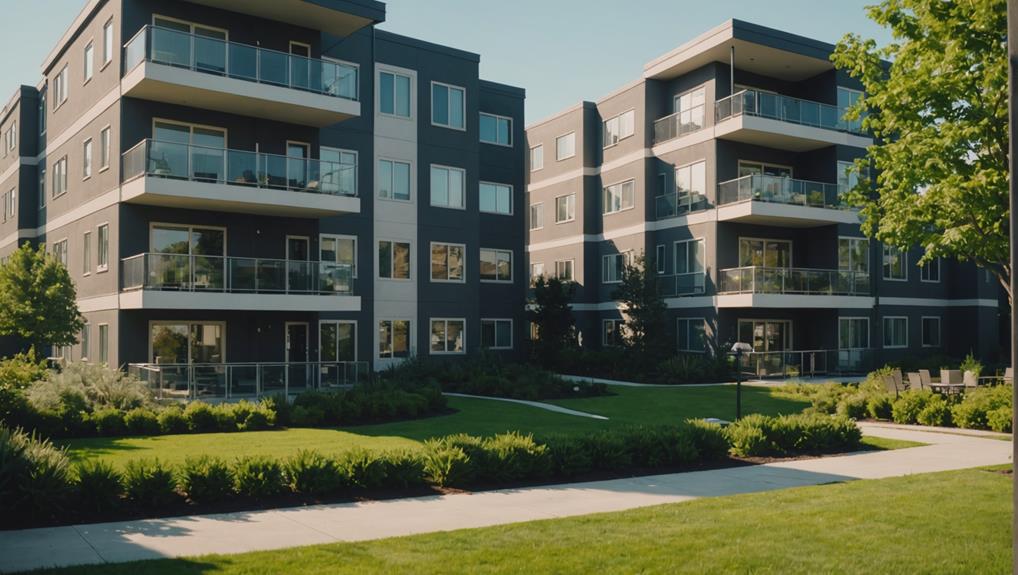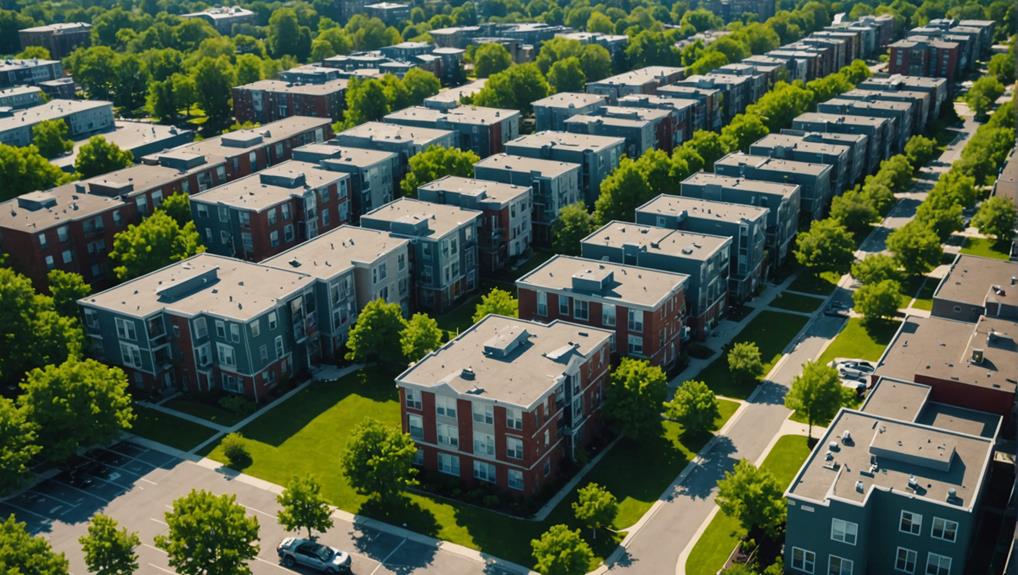Maximizing returns on your commercial multifamily real estate investment requires a comprehensive approach that balances market analysis, operational efficiency, and strategic improvements.
Core strategies include:
- Optimizing rental income through precise lease rate adjustments.
- Fostering tenant satisfaction to ensure high occupancy.
- Undertaking targeted property upgrades.
Reducing operational costs and employing strong financial management techniques are critical to sustaining profitability.
The intricate interplay between these elements and the specific tactics involved can significantly influence outcomes.
To understand how these strategies can be effectively implemented and tailored to your investment portfolio, consider the following insights.
Key Insights
- Conduct thorough market research to stay informed about economic indicators, demographic trends, and local infrastructure developments.
- Regularly analyze local market data and competitive rent surveys to optimize lease rates.
- Implement tenant retention strategies, including lease renewal incentives and exceptional customer service.
- Invest in property renovations and upgrades to enhance rental income and increase property value.
- Reduce operating expenses by adopting energy-efficient technologies and negotiating bulk contracts with vendors.
Understanding Multifamily Real Estate

Multifamily real estate encompasses residential properties designed to house multiple separate families within a single building or complex, such as apartment buildings and rental communities. This sector offers investors a reliable income stream, as rental payments from numerous tenants mitigate the risk of income loss due to vacancies. Market trends and demographic shifts play a crucial role in determining the potential returns on multifamily investments. By analyzing these factors, investors can pinpoint lucrative opportunities and anticipate changes in tenant demand.
Multifamily properties also benefit from economies of scale; operating expenses are distributed across many units, which enhances profitability. Understanding these dynamics is vital for maximizing returns and ensuring the long-term viability of multifamily real estate investments.
Analyzing Market Trends

Analyzing market trends is essential for understanding the economic indicators, demographic changes, and local infrastructure developments that impact commercial multifamily real estate investments.
Monitoring these factors allows investors to anticipate fluctuations in property values and adjust their strategies accordingly.
This proactive approach enables informed decision-making, enhances potential returns, and mitigates risks effectively.
Economic Indicators Analysis
Analyzing market trends in commercial multifamily real estate necessitates a comprehensive review of key economic indicators such as GDP growth, employment rates, and interest rates. These indicators offer crucial insights into the economy's overall health, which directly impacts property values and rental demand. Conducting thorough market research is essential for identifying these trends accurately.
Demographic trends, including population growth and age distribution shifts, are also critical in forecasting future market conditions. Local market conditions, such as vacancy rates and rental prices, provide a detailed view of current dynamics. Additionally, government policies and infrastructure developments can indicate long-term changes.
Demographic Shifts Impact
Analyzing economic indicators is crucial, but examining demographic shifts like increasing urbanization and evolving household structures is equally important for informed investment decisions in commercial multifamily real estate.
Location analysis becomes vital as these shifts influence rental demand, occupancy rates, and property values. Monitoring factors such as changing household sizes, age distributions, and income levels helps adapt investment strategies effectively.
Understanding population growth in key areas identifies opportunities and anticipates shifts in housing preferences. Staying informed about these trends ensures investments align with tenant profiles, maximizing returns.
Evaluating demographic changes allows investors to capitalize on emerging market trends, ensuring sustainable profitability in multifamily real estate investments.
Local Infrastructure Developments
Evaluating the impact of local infrastructure developments on multifamily real estate investments is essential for forecasting property value appreciation and rental demand. Analyzing new public transportation lines or road expansions reveals trends that boost property values. Projects like schools, hospitals, and shopping centers enhance rental demand. Monitoring city planning initiatives and zoning changes can identify growth areas. Proximity to these developments attracts tenants seeking convenience and accessibility. Enhancements such as parks, bike lanes, and cultural amenities significantly increase the desirability of your investment.
| Infrastructure Type | Potential Impact |
|---|---|
| Public Transportation | Heightened property values |
| Nearby Amenities | Augmented rental demand |
| Accessibility | Increased tenant attraction |
| Cultural Amenities | Enhanced property desirability |
Property Selection Criteria

Selecting the right property for a commercial multifamily real estate investment requires a thorough evaluation of key factors to ensure sustained profitability and growth. Property valuation is essential for determining fair market value, while understanding market trends helps gauge rental rates and occupancy levels.
Evaluating the property's condition, age, and potential for renovations can significantly enhance rental income and property value. Effective property management is crucial for maintaining operational efficiencies and controlling maintenance costs.
Proximity to transportation hubs and neighborhood amenities also plays a vital role in attracting and retaining tenants. A careful assessment of these criteria optimizes investment returns and supports long-term profitability.
Comprehensive Investment Strategy

A comprehensive investment strategy in commercial multifamily real estate relies on thorough market research and exploration. Detailed market analysis identifies emerging trends and opportunities, facilitating informed decisions.
Diversifying across property types and locations spreads risk, enhancing both the stability and potential returns of the investment portfolio.
Market Research Importance
Effective market analysis forms the foundation of a comprehensive investment strategy in commercial multifamily real estate. By scrutinizing market research, investors can identify crucial trends in vacancy rates, rental prices, and demographic shifts that influence investment outcomes.
Understanding local zoning laws and government policies is equally vital for adjusting strategies to maximize returns. Additionally, monitoring economic indicators such as employment rates and population growth helps anticipate changes in property values and rental demand.
Staying informed about market conditions and emerging trends allows investors to make well-informed decisions, capitalizing on potential growth areas. Thorough market analysis thus equips investors with the necessary insights to navigate the complexities of commercial multifamily real estate effectively.
Diversification Benefits
Regularly expanding investments in commercial multifamily real estate can significantly mitigate risks and improve portfolio stability. Diversification benefits are pivotal in creating a sturdy investment strategy. Engaging in portfolio diversification enables investors to better navigate market fluctuations and safeguard their assets.
A comprehensive investment strategy, such as buy and hold, is enriched through diversification across various property types and locations.
Here are four essential diversification benefits:
- Risk Mitigation: Spreading investments across different properties and locations reduces exposure to downturns in any single market.
- Stable Returns: Diverse investments can provide a more consistent income stream.
- Growth Opportunities: Exploring different markets opens avenues for potential appreciation.
- Balanced Portfolio: A varied portfolio helps offset poor performance in one area with gains in another.
Effective Property Management

Maintaining property value, ensuring tenant satisfaction, and optimizing operational efficiency are fundamental components of effective property management in commercial multifamily real estate investments. Key areas of focus include tenant screening, lease management, and maintenance. Proper tenant screening ensures reliable occupants, which reduces turnover and associated costs. Effective lease management involves clear agreements and timely renewals, fostering stable income. Regular maintenance preserves property value and enhances tenant experience, contributing to higher retention rates.
| Vital Aspects | Description |
|---|---|
| Tenant Screening | Ensures reliable occupants, reduces turnover |
| Lease Management | Facilitates clear agreements, timely renewals |
| Maintenance | Preserves property value, improves tenant experience |
Strong property management practices, whether through self-management or professional firms, are crucial for long-term profitability and success.
Maximizing Rental Income

Maximizing rental income in commercial multifamily real estate involves strategic approaches. This includes optimizing lease rates through comprehensive market research. Enhancing tenant retention with targeted incentives is also crucial. Investing in property renovations plays a significant role in this process.
Setting competitive rental rates and adjusting them regularly based on market trends ensures high occupancy levels and income stability. Implementing technology for efficient management and communication streamlines operations. This contributes to the overall financial performance.
Lease Rate Optimization
Optimizing lease rates is essential for maximizing rental income in commercial multifamily real estate investments. Property managers should focus on:
- Analyzing Market Trends: Regularly review local market data to set competitive lease rates that reflect current conditions and drive rental income.
- Conducting Rent Surveys: Periodically survey nearby properties to ensure your rates remain attractive and adjust as needed.
- Offering Incentives: Use rent discounts or added amenities to attract tenants, thus enhancing overall income.
- Proactive Lease Renewal: Implement strategies to encourage lease renewals, reducing vacancies and sustaining consistent cash flow.
These methods will help ensure your property remains competitive and profitable, securing long-term financial success.
Tenant Retention Strategies
To complement lease rate optimization, implementing strong tenant retention strategies is vital for maintaining consistent rental income and enhancing property profitability.
Key strategies include offering lease renewal discounts to incentivize tenants to stay longer, thereby reducing turnover rates.
Exceptional customer service is fundamental, as it ensures tenant concerns are promptly addressed, fostering satisfaction and loyalty.
Regular communication and well-maintained properties further improve tenant retention.
Conducting annual lease reviews and market analysis allows for competitive rental rate adjustments, ensuring consistent revenue growth.
Utilizing tenant feedback to incorporate desirable amenities or services attracts and retains quality tenants, solidifying stable cash flow and maximizing overall investment profitability.
Renovation and Upgrades
Strategic investments in renovations and upgrades can significantly enhance the rental value and appeal of multifamily properties. Allocating capital expenditures (capex) to targeted improvements can achieve substantial value-add.
Consider these strategies:
- Kitchen and Bathroom Renovations: Updating these areas can increase rental income by an average of 3-5%, making them some of the most impactful upgrades.
- Energy-Efficient Installations: Implementing energy-efficient appliances and lighting attracts eco-conscious tenants and reduces utility costs, enhancing the property's overall appeal.
- Adding Amenities: Incorporating features like a fitness center or outdoor space can command higher rents and improve tenant retention.
- Upgrading Common Areas and Landscaping: Enhancing these spaces boosts curb appeal and creates a more desirable living environment, attracting and retaining tenants.
These renovations and upgrades not only maximize rental income but also ensure long-term property value.
Reducing Operating Expenses

Implementing energy-efficient upgrades and negotiating bulk contracts with vendors can significantly reduce operating expenses in commercial multifamily real estate investments.
Conducting a thorough cash flow analysis helps identify areas where maintenance and repairs can be optimized, reducing unnecessary capital expenditures.
Upgrading to LED lighting can cut utility costs by up to 50%, while water-saving fixtures lower water expenses.
Bulk contracts with maintenance vendors ensure cost-effective solutions for recurring services and repairs.
Regular maintenance checks prevent costly, unexpected repairs and extend the lifespan of critical equipment.
Property management software streamlines operations, automating tasks to further decrease operational costs and improve overall efficiency, thus maximizing returns on investment.
Leveraging Value-Add Opportunities

Leveraging value-add opportunities in multifamily real estate involves making targeted improvements that amplify property value and rental income potential. By strategically renovating and upgrading properties, investors can significantly enhance their capitalization rate (cap rate) and debt service coverage ratio (DSCR). This leads to higher property appreciation and improved cash flow.
Essential value-add strategies include:
- Renovations: Upgrading units with modern finishes and appliances attracts higher-quality tenants.
- Amenity Additions: Installing desirable amenities like fitness centers or communal spaces increases tenant satisfaction and retention.
- Energy Efficiency: Implementing energy-saving measures reduces operating costs and appeals to eco-conscious renters.
- Strategic Management: Refining property management practices improves tenant relations and operational efficiency.
Careful market analysis is crucial for successful value-add opportunities.
Utilizing Technology and Data

Harnessing technology and data is essential for optimizing the management and performance of commercial multifamily real estate investments. Property management software streamlines operations by efficiently tracking maintenance requests, managing lease agreements, and facilitating online rent collection, thereby boosting cash flow management.
Data analytics allow investors to monitor crucial performance indicators such as occupancy rates, rental income, and expense trends, enabling informed decision-making. Smart building technology enhances energy efficiency, improves security, and enables remote monitoring of property systems, ensuring operational excellence.
Virtual tours and online platforms significantly broaden marketing reach, attracting potential tenants more effectively. Integrating these technological advancements leads to improved efficiency, higher tenant satisfaction, and ultimately, maximized returns on investment.
Financing and Capital Structure Optimization

Optimizing capital structure in commercial multifamily real estate investments requires exploring diverse financing options. These options include traditional mortgage financing, private lenders, and government programs, each affecting terms and conditions and, consequently, overall returns.
Key financial metrics to consider include:
- Mortgage Financing: Evaluate both traditional and alternative loan options to secure favorable terms.
- Capitalization Rate (Cap Rate): Analyze this metric to gauge the potential return on investment.
- Debt Service Coverage Ratio (DSCR): Confirm that the property generates enough income to meet debt obligations.
- Leverage and Equity: Utilize debt strategically alongside equity to maximize investment profitability.
These elements are essential for securing financing that supports both property acquisition and value-added improvements.
Conclusion
To maximize returns in commercial multifamily real estate investment, a multifaceted approach is essential. This involves thorough market analysis, strategic property selection, and effective management practices.
Key strategies include:
- Optimizing lease rates
- Enhancing tenant retention
- Undertaking property renovations to achieve high occupancy rates and consistent revenue growth
Lowering operating expenses and capitalizing on value-add opportunities are crucial. Leveraging technology and data also play a significant role.
Optimizing financing and capital structures further ensure long-term profitability and resilience in the multifamily real estate sector.





